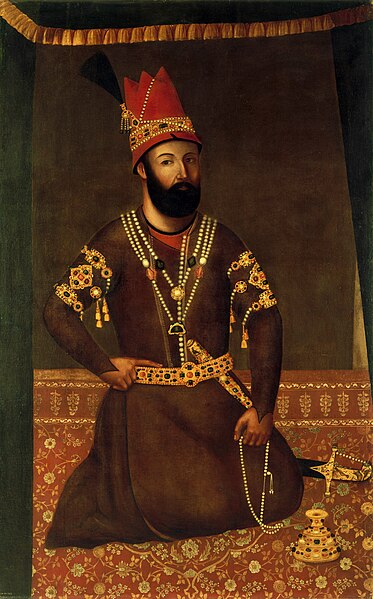The campaigns of Nader Shah, or the Naderian Wars, were a series of conflicts fought in the early to mid-eighteenth century throughout Central Eurasia primarily by the Iranian conqueror Nader Shah. His campaigns originated from the overthrow of the Iranian Safavid dynasty by the Hotaki Afghans. In the ensuing collapse and fragmentation of the empire after the capture of the Iranian capital of Isfahan by the Afghans, a claimant to the Safavid throne, Tahmasp II, accepted Nader into his service. After having subdued north-west Iran as well as neutralising the Abdali Afghans to the east and turning Tahmasp II into a vassal, Nader marched against the Hotaki Afghans in occupation of the rest of the country. In a series of incredible victories the Afghans were decimated and Tahmasp II returned to the throne as a restored Safavid monarch.
Portrait of Nader Shah
An Eugène Flandin's impression of a gunpowder depot near old Tehran (eighteenth century).
A military diagram demonstrating the key manoeuvres in the campaign of Afghanistan
Isfahan (here depicted from the north-to-south direction), as the capital of Iran, was the ultimate objective of Nader's campaign for the liberation of Iran from Hotaki rule
Nader Shah Afshar was the founder of the Afsharid dynasty of Iran and one of the most powerful rulers in Iranian history, ruling as shah of Iran (Persia) from 1736 to 1747, when he was assassinated during a rebellion. He fought numerous campaigns throughout the Middle East, the Caucasus, Central Asia, and South Asia, such as the battles of Herat, Mihmandust, Murche-Khort, Kirkuk, Yeghevārd, Khyber Pass, Karnal, and Kars. Because of his military genius, some historians have described him as the Napoleon of Persia, the Sword of Persia, or the Second Alexander.
Nader belonged to the Turkoman Afshars, one of the seven Qizilbash tribes that helped the Safavid dynasty establish their power in Iran.
Contemporary portrait of Nader Shah. Artist unknown, created in c. 1740 in Iran. Now located in the British Library in London.
Statue of Nader Shah at his tomb.
Court scene with Tahmasp II in the centre, and Nader to his left. From a illustrated Indian copy of the Jahangosha-ye Naderi, dated 1757/58
Nader Shah and two of his sons








